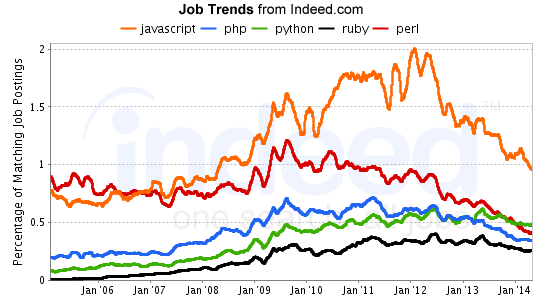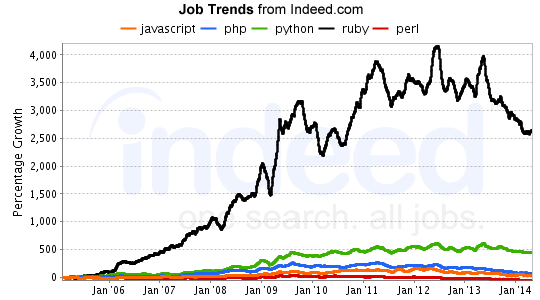Programming Language Job Trends Part 2 – August 2014
In part 1 of the programming language job trends, we reviewed Java, C++, C#, Objective C, and Visual Basic. In today’s installment, we will review trends for PHP, Python, JavaScript, Ruby, and PERL. Watch for part 3 in the next few days, where we will look at some emerging languages and others gaining steam.
First, let’s look at the trends from Indeed.com:
Much like the languages in part 1, there is a general downward trend for about 2 years. JavaScript still leads comfortably with Python demand staying almost flat during the past two years. PERL has been in a long decline since 2010, but still stays above PHP and Ruby. PHP had stayed flat for a while, but the past year has not been kind, with a more significant downward trend. Ruby trails, but like Python, has been almost flat for close to three years and is closing the gap with PHP and PERL. The stability of the Python and Ruby trends is probably due to their growth in non-startup environments.
Much like part 1 of the job trends, the SimplyHired trends are mostly unusable. The data is definitely close to current, but wild swings in demand show me that I cannot trust the data. I will review SimplyHired again in the next installment.
Lastly, we look at the relative growth trends from Indeed.com:
Given what the job demand graph shows, it seems surprising that the Ruby growth would outpace all of the others so dramatically. However, due to the length of time in these charts, where Ruby did not have much demand in 2006, the growth is a little misleading. When you look at the remaining languages, Python has a clear lead on the others, hovering at 500% for the past three years. PHP and Javascript come next, but still below 100% growth. PERL lags the group, near -50% growth.
The overall demand trend is similar to the trends in part 1, though these languages show a little more stability. The stability of Ruby and Python are a bright spot in some otherwise dismal trends in Part 1 and this Part 2. For people looking to learn new languages for web development or even some scripting, PERL seems to be losing relevance. I think Python and Ruby have taken over in both of those cases. Due to the popularity of Web CMS systems like WordPress, PHP demand may decline but will stick around for a long time. Please visit the blog in a few days when we look at some relatively newer languages to see if the trends remain the same.
| Reference: | Programming Language Job Trends Part 2 – August 2014 from our JCG partner Rob Diana at the Regular Geek blog. |







